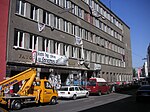Austrian Institute of Economic Research
The Austrian Institute of Economic Research (German: Österreichisches Institut für Wirtschaftsforschung, WIFO) is a private non-profit association located in Vienna, Austria. The institute was founded in 1927 by Friedrich Hayek and Ludwig von Mises as Österreichischen Institut für Konjunkturforschung ("Austrian Institute for Business-Cycle Research"). With 124 employees (64 researchers, 30 research assistants, 30 administrative staff) it is the largest economic research institute in Austria. The current director is Gabriel Felbermayr who followed Christoph Badelt on 1 October 2021. WIFO is a member of the "Association of European Conjuncture Institutes" (AIECE), the "Centre for International Research on Economic Tendency Surveys" (CIRET), and the "European Economic Research and Advisory Consortium" (ERECO) with partner institutions in Birmingham, Bologna, Cambridge, Madrid, Munich, Paris and Rotterdam. It has also established ties to institutes in the US, Australia and Asia.
Excerpt from the Wikipedia article Austrian Institute of Economic Research (License: CC BY-SA 3.0, Authors).Austrian Institute of Economic Research
Kirchenweg, Vienna KG Landstraße (Landstraße)
Geographical coordinates (GPS) Address Nearby Places Show on map
Geographical coordinates (GPS)
| Latitude | Longitude |
|---|---|
| N 48.181577777778 ° | E 16.389938888889 ° |
Address
Kirchenweg
Kirchenweg
1030 Vienna, KG Landstraße (Landstraße)
Austria
Open on Google Maps










